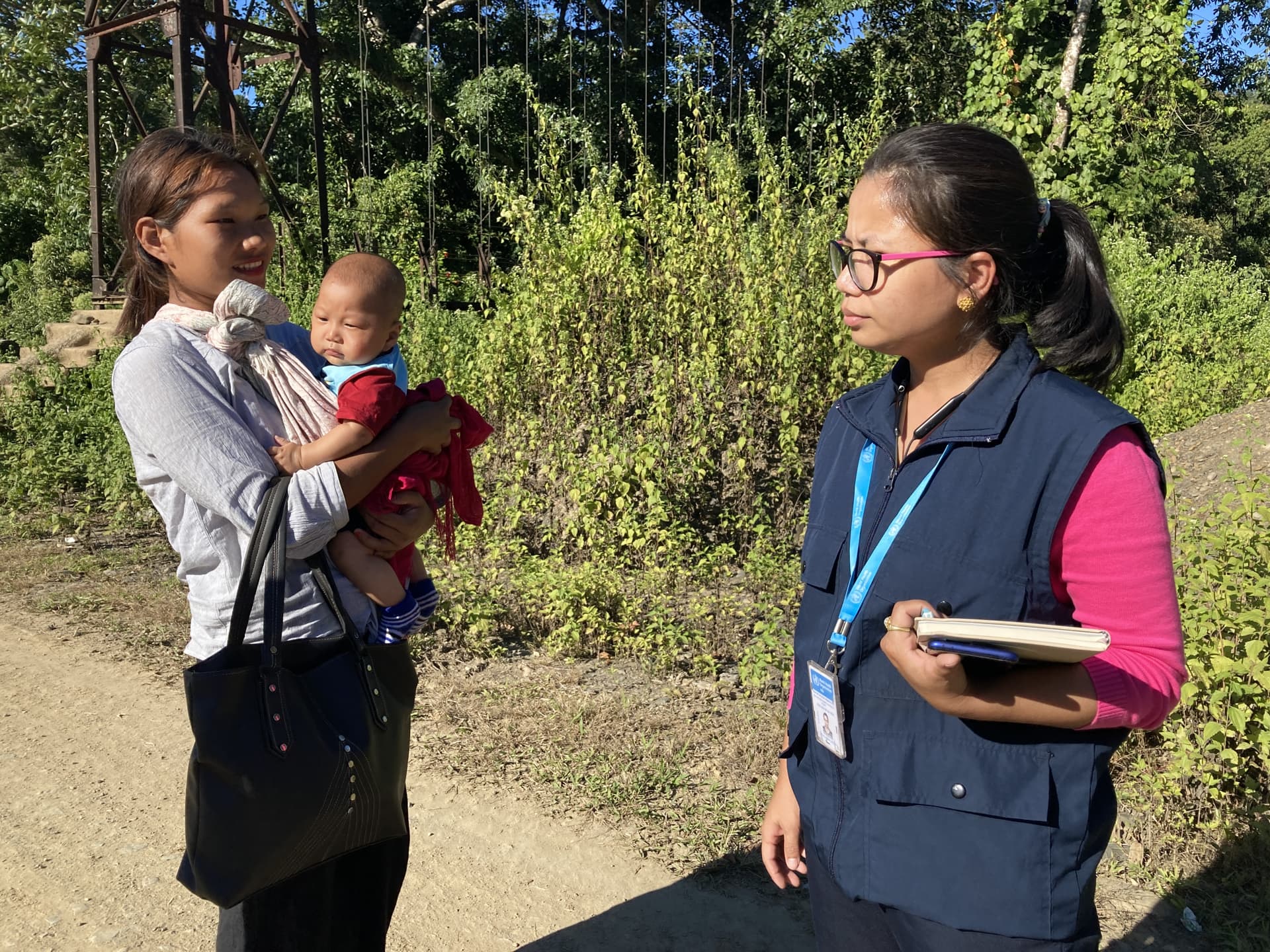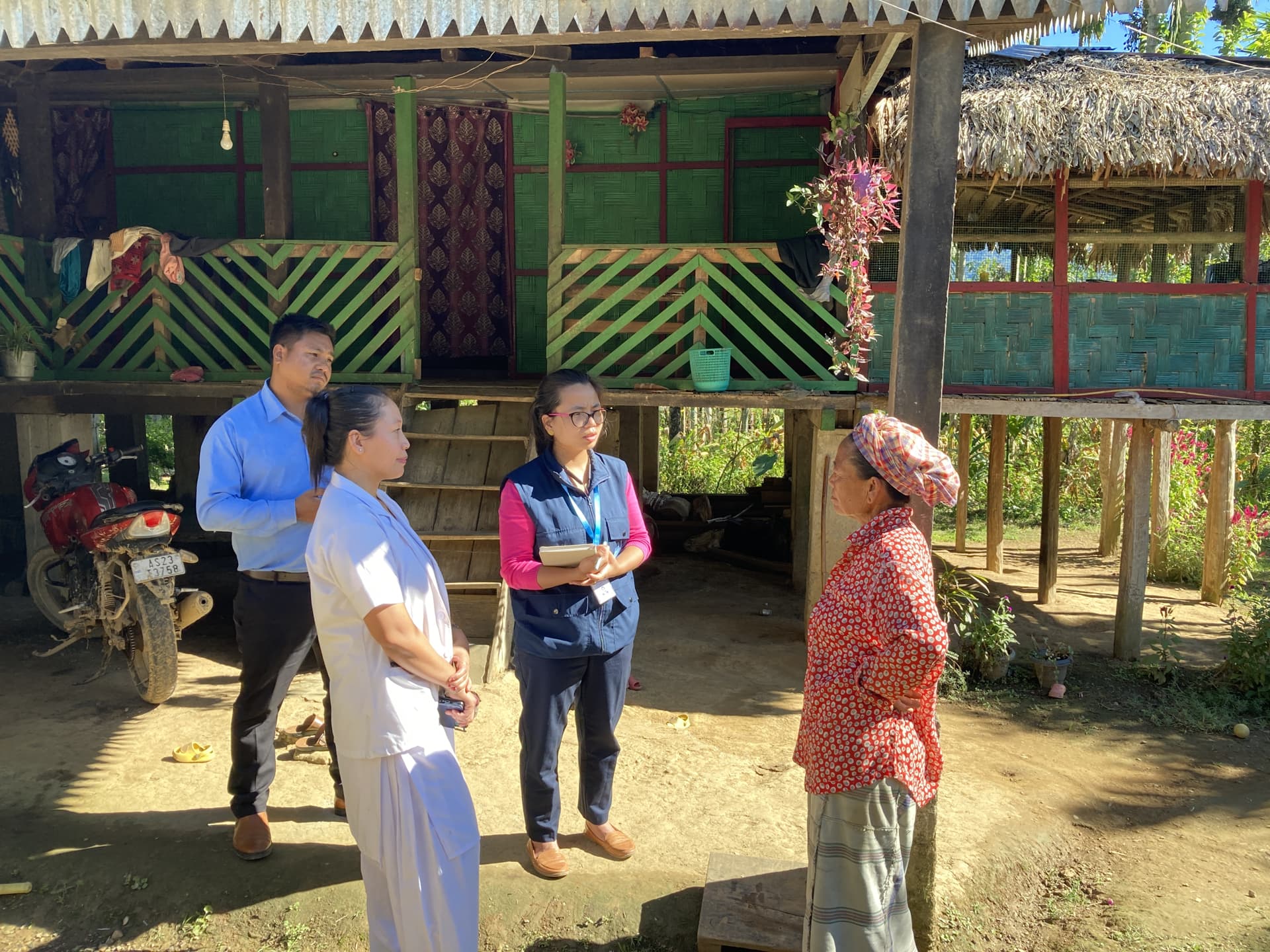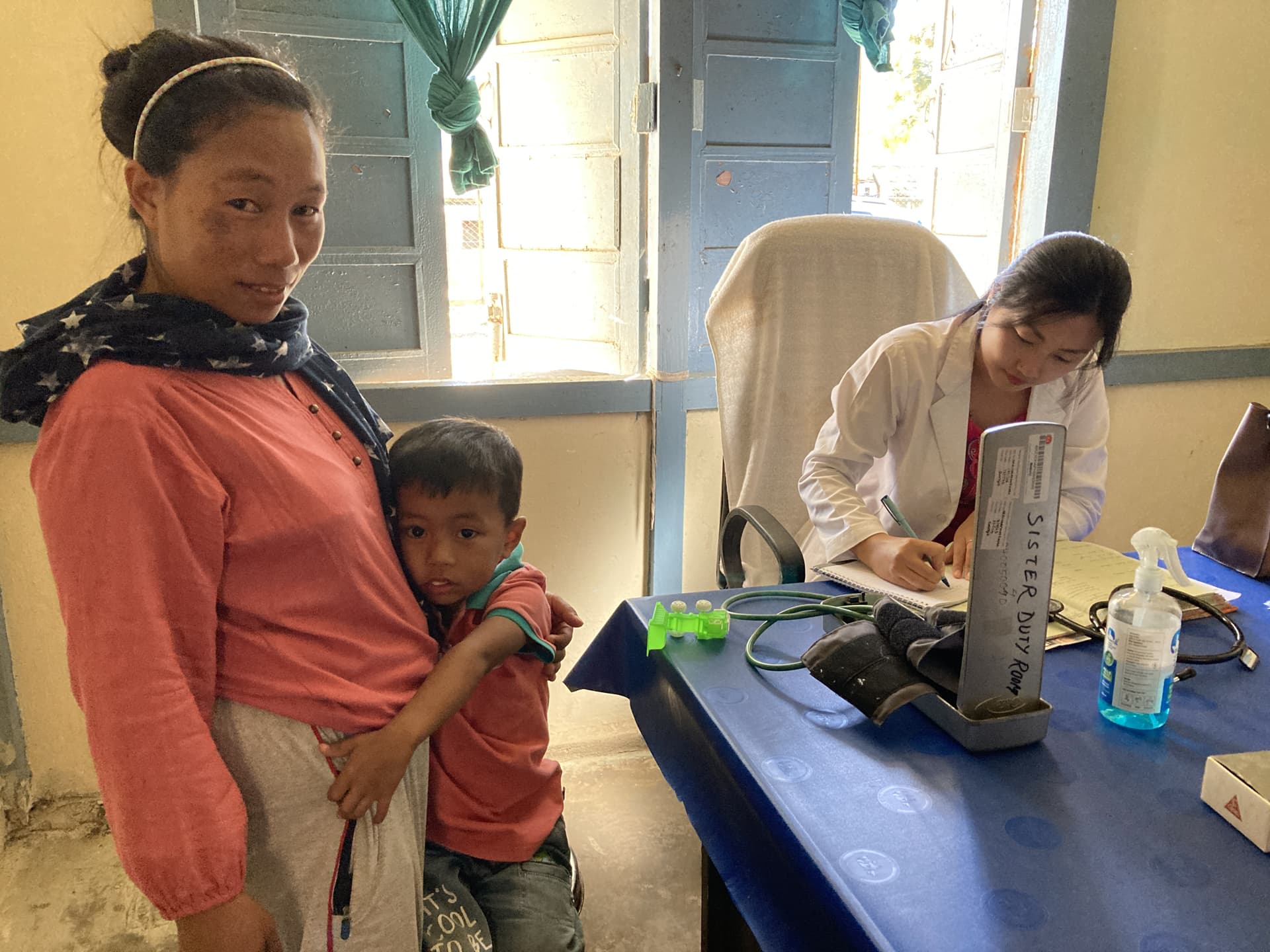The river Rima runs through Lungpang village in the hilly Changlang district of Arunachal Pradesh, dividing it into Lungpang-I and -II. The shortest way to reach Lungpang-II is to park vehicles across the river and cross over a pedestrian suspension bridge. Ms Sincha Tikhak, auxiliary nurse midwife (ANM) at Primary Health Centre (PHC) Nampong, and the WHO National Public Health Support Network (NPSN) team, use this bridge to reach the homes of beneficiaries for house-to-house monitoring of routine immunization and health services.
The first family they visit is the Mossang home, where the active two-year-old Khimthoi spends his day with his building blocks or chasing hens around the yard. “I don’t know where he gets the energy from, he keeps me on my feet all day,” said Ms Hamnon Mossang, 24, who lives in Lungpang-II village.

The WHO team from Namsai district, Arunachal Pradesh, and auxiliary nurse midwife Ms Sincha Tikhak (left) discuss Khimthoi’s immunization schedule with his mother Ms Hamnon Mossang in their home Lungpang-II village in Changlong district (Photo: Sanchita Sharma / © WHO India)
Khimthoi’s immunization card is among many reviewed by the health team across three villages in one day. It shows he was born on 24 April 2021 with a healthy birthweight of 3.1 kg. His routine vaccinations are up to date, despite the closest health sub-centre in Rima Putok being 10 km away. “We get him immunized at outreach clinics organized by the district medical team. Now that he is older, his father takes him to the sub-centre on his motorbike, when needed,” said Ms Mossang.
House-to-house monitoring, where independent monitors visit homes to assess the immunization status of children, is one of the best practices for assessing the performance and quality of services being provided. It was an integral part of India’s polio eradication endgame along with polio vaccination to maintain high population immunity and surveillance for acute flaccid paralysis, a primary symptom of polio infection, and environmental surveillance of sewage outflow to detect infection in the community. These actions are continuing to ensure India maintains its polio status since the last polio case was reported in West Bengal on 13 January 2011.

A young mother on her way back from a health centre shares her experience with WHO surveillance medical officer in Lungpang-II village in Changlang district, Arunachal Pradesh. (Photo: Sanchita Sharma / © WHO India)
House-to-house monitoring further enable the health department to identify clusters and subdistricts with poorly coverage; reasons why children were not vaccinated; and assess quality of reported data. Acting on the data, district health teams revisit and vaccinate missed children; improve microplanning for the next round, especially in missed areas; and address challenges for low coverage, such as vaccine hesitancy or migratory population, through community engagement, advocacy and other customized actions.
The PHC Napong and WHO teams meet families of all the children under the age of 5 years in Lungpang-II in a little over four hours, before heading to other villages.

WHO-NPSN surveillance medical officer supports auxiliary nurse midwife Ms Sincha Tikhak (in white) conducting house-to-house surveillance for routine immunization in Tikhak Rima Putok village in Changlang district, Arunachal Pradesh, India. (Photo: Sanchita Sharma / © WHO India)
The picturesque Tikhak Taipi village in Changlang district has 22 homes and a population of 127 persons, according to Nampong Circle Village Survey 2022. Most families have farm holdings. “We interact a lot with grandparents, who are often the primary caregivers when the parents are away at work in the fields. Counselling grandparents on the importance of full immunization is a powerful to ensure children under five are brought for immunization and other services,” said Ms Tikhak, ANM, PHC Nampong, which provides services to a 2658 population living across 557 homes in 17 sparsely populated villages. PHC Nampong is the last PHC before Pangsa Pass (3727 metres) at India’s border with Myanmar.
Home visits to monitor the immunization status of children and the quality of routine health services of beneficiaries is an integral part of WHO field support to state governments and district administration to ensure timely, complete, and accurate reporting of immunization indicators. This includes monitoring outreach vaccination services, supportive supervision to healthcare workers, linking services with communities, utilizing immunization data for planning and action, and optimizing management of resources through micro-plans.
-monitors-data-entry-with-nodal-officer.jpg?sfvrsn=e2ff2bf8_2)
HO surveillance medical officer (right) monitors data entry with nodal officer Ms Jotik Chithan and auxiliary nurse midwives Ms Narang Lama (centre) and Ms Sincha Tikhak at Primary Health Centre Nampong, Changlang district, Arunachal Pradesh (Photo: Sanchita Sharma / © WHO India)
“Complementing fixed-point facility immunization with community-driven outreach immunization strategy to reach remote areas and underserved communities improves access to immunization and health services. It also compounds trust in public health services and improves utilization of services available in health facilities,” said Dr Roderico H. Ofrin, WHO Representative to India.
Household visits also offer ANMs and WHO teams the opportunity to offer interactive counselling to the families and caregivers about their health concerns. WHO NPSN officers also meet the village ASHAs (community health volunteers) to seek information to share updates to enable them to share informed responses to concerns of each family.
“ANMs work closely with ASHAs, who are from the community, to plan outreach activities, track ‘missed’ children, and social mobilization in hard-to-reach areas, particularly in difficult terrain where households are isolated. WHO teams support monitoring and evaluation of immunization and quality of services for accurate data collection to inform decision-making,” said Ms Tikhak.

Dr Kobton Mossang, general duties medical officer, with a pregnant woman and her son at PHC Nampong, Changlang district, Arunachal Pradesh (Photo: Sanchita Sharma / © WHO India)
Equitable access to quality comprehensive healthcare services by everyone who needs them is key to achieving universal health coverage. “To improve immunization coverage for women and children, routine immunization data is used to identify underserved and hard-to-reach areas for targeted outreaches that are adapted and customized to meet the needs and lifestyle of the community. We work in close coordinaton with ASHAs to both create demand and deliver services to optimize reach and ensure sustained access and utilization of health services in hard-to-reach areas,” said Ms Narang Lama, ANM, PHC Nampong.
There are 28 pregnant women receiving ante-natal care at PHC Nampong. The leading ailments are gastritis, renal stones and fungal skin infections, but hypertension cases are increasing. “Noncommunicable diseases clinics are held once a month and we get some cases of hypertension, though there is not much diabetes. Chewing tobacco use is high here – most people chew sada pata (air-cured loose tobacco leaf), we also counsel people about quitting tobacco use and the signs of oral cancers,” said Dr Kobton Mossang, general duties medical officer, PHC Nampong.
